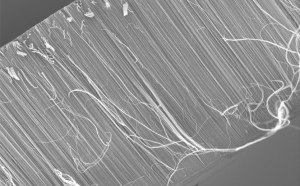A new nanoparticle filtration system could usher in the next generation of portable water purification devices, which could give relief to 780 million people around the world struggling to gain access to clean water supply.

Image from CSIRO
Scientists from CSIRO’s world-leading Plasma Nanoscience Laboratories, Dr Zhaojun Han and Professor Kostya (Ken) Ostrikov, joined an international team of researchers to study how plasma-treated carbon nanotubes could enhance water purification membranes which could eventually become ideal for removing contaminants and brine from water.
While other portable devices already exist, Dr. Han says they are unable to filter out organic contaminants because they only rely on reverse osmosis and thermal processes.
“For people in remote locations, briny water can sometimes be the only available water source,” says Dr. Han. “That’s why it’s important to not only be able to remove salts from water, but to also be able to put it through a process of purification.”
“Our study showed that carbon nanotube membranes were able to filter out ions of vastly different sizes – meaning they were able to remove salt, along with other impurities,” he says.
Dr. Han says the membranes could be integrated into portable water purification devices the size of a teapot and would be rechargeable, inexpensive and more effective than many existing filtration methods. This would allow contaminated water to enter from one end and come out clean and safe for drinking on the other.
“Small portable purification devices are increasingly recognised as the best way to meet the needs of clean water and sanitation in developing countries and in remote locations, minimising the risk of many serious diseases,” he said.
Professor Ostrikov meanwhile credits the success of the new membranes to the unique properties of plasma treated carbon nanotubes.
“Firstly, ultralong nanotubes have a very large surface area that is ideal for filtration. Secondly, nanotubes are easy to modify, which allows us to tailor their surface properties through localised nanoscale plasma treatment,” he says.
According to the CSIRO media release, the researchers plan to extend the study by looking into the filtration properties of other nanomaterials.
Led by Associate Professor Hui Ying Yang from Singapore University of Technology and Design, the research is a collaborative work between SUTD, CSIRO, Massachusetts Institute of Technology (MIT), the University of Sydney, and Hong Kong Polytechnic University.














